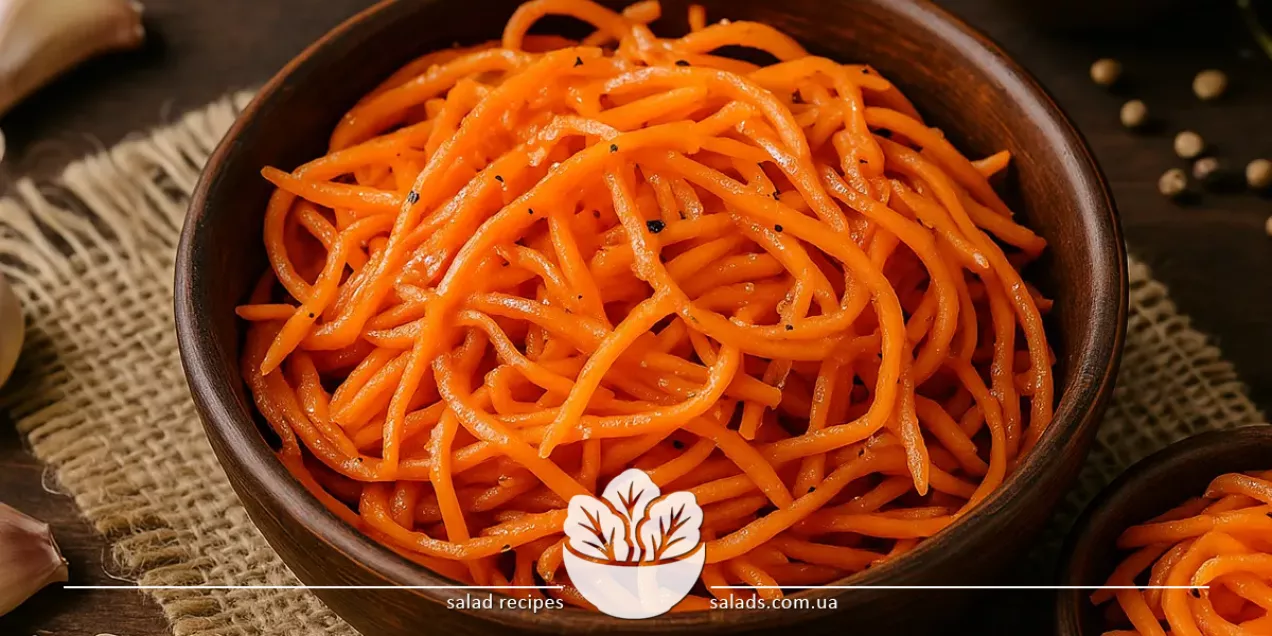
Korean-Style Carrot

Korean-style carrot is a spicy, aromatic, and juicy appetizer made from fresh carrots, garlic, vinegar, spices, and toasted oil. It is often used as a separate dish or as a component in salads, appetizers, rolls, side dishes, or even main courses. This ingredient brings a vibrant flavor and spicy note to recipes, pairing well with vegetables, meat, cheese, and eggs. In the root vegetables section, you can also find other ingredients that complement your menu and diversify flavor combinations.
Salad Recipes with Korean-Style Carrot
Salads with Korean-Style Carrot: Spice and Colorful Appeal
Korean-style carrot has become a favorite ingredient in many salads thanks to its spicy flavor and appetizing appearance. It pairs perfectly with boiled meat, eggs, cheese, and both fresh and canned vegetables, adding bold character to salads. Most of the time, it doesn’t require extra dressing, as it already contains vinegar, spices, and oil. A common example is a salad with chicken, egg, cheese, and Korean-style carrot, served layered or mixed. In festive recipes, it’s combined with mushrooms, corn, olives, or smoked meats. It’s also a key element in light vegetable salads with cucumber, bell pepper, or cabbage. Its spiciness balances the softness of other ingredients. For instance, in a salad with chicken egg, boiled fillet, corn, and hard cheese, the carrot adds a tangy touch and colorful contrast. This combination is vibrant, hearty, and harmonious, making it suitable for everyday meals or festive occasions.
Appetizers with Korean-Style Carrot: Rolls, Tartlets, and Stuffed Dishes
Korean-style carrot is often used in cold appetizers, where it serves as a bold filling or accent ingredient. Its spicy flavor pairs well with mild components such as eggs, cheeses, boiled meats, or creamy sauces. It can be layered, rolled into wraps, or spooned into tartlets, creating dishes with interesting tastes and visual appeal. One of the most popular options is lavash with Korean-style carrot, chicken fillet, processed cheese, and herbs. Carrot is also placed into tartlets with hard cheese, boiled egg, or mayonnaise, forming an eye-catching appetizer for festive tables. In stuffed eggs or vegetables, it acts as a contrasting filling that adds a spicy kick. For example, in lavash rolls with chicken fillet, Korean-style carrot, cheese, and garlic, you get a balance of tenderness and heat. In stuffed tomatoes or peppers, the carrot provides vivid color and intense flavor. These appetizers are quick to prepare, store well, and always look appetizing.
Hot Dishes with Korean-Style Carrot: Unexpected but Delicious Combinations
While Korean-style carrot is typically served cold, it’s surprisingly effective in hot dishes as well. It can be added to casseroles, omelets, pies, rolls, and even pan-fried or baked meat. Its spice and juiciness complement soft proteins, cheese, or dough, creating a striking contrast of textures and flavors. Casseroles with potatoes or pasta are often enhanced with this ingredient – carrot is mixed with egg, mayonnaise, or cheese and layered. It’s also used as a filling in meat rolls or stuffed chicken breasts. In pies made from puff or yeast dough, carrot is paired with egg, meat, or cheese to make a tangy stuffing. A creative option includes hot snack-style pancakes or lavash wraps filled with Korean-style carrot, hard cheese, and hard cheese, pan-fried until crispy. This dish is suitable for dinner, snacking, or a buffet. Korean-style carrot in hot dishes is not only a bold choice but also a way to refresh familiar recipes.
Sandwiches, Subs, and Shawarma with Korean-Style Carrot
Korean-style carrot works wonderfully in a variety of sandwiches, subs, and fast food dishes. It brings expressiveness, juiciness, and a hint of spicy aroma. With its soft texture, the carrot lays well in baguettes, lavash, buns, and even tartlets, creating a flavorful layer combined with meat, cheese, eggs, or greens. Popular options include hot chicken shawarma with vegetables and Korean-style carrot, subs with sausage or cutlets, and sandwiches on dark bread with meat or cheese spreads. The carrot balances juicy and fatty components, harmonizes the flavor, and enhances the dish’s visual appeal. In vegetarian versions, it’s paired with vegetables, hummus, or yogurt-based sauces. For instance, a sandwich with boiled sausages, lettuce, cucumber, and Korean-style carrot is colorful, hearty, and refreshing. This ingredient transforms a simple meal into something new and exciting, while making snacks more wholesome and flavorful.
Pairing Korean-Style Carrot with Other Ingredients in Creative Dishes
Korean-style carrot opens up a wide range of possibilities for culinary experimentation. It’s paired not only with classic components like meat, eggs, and cheese but also with more unconventional products. Its spice, freshness, and texture work well in dishes with vegetables, grains, fish, sauces, and crunchy elements. This allows for the creation of signature salads, spicy bowls, rolls, or even baked vegetable cakes. The carrot is mixed with rice, legumes, or bulgur, served in bowls with avocado, egg, and greens, or layered with meat and vegetables in glass serving dishes. In vegetarian meals, it serves as a central accent that compensates for the lack of protein by adding flavor depth. In fish or seafood dishes, it creates intriguing taste contrasts. For example, a salad with Korean-style carrot, greens, egg, and slices of fresh tomato offers a fresh, balanced, and spicy profile. This ingredient adapts easily to various culinary styles and presentation formats – from home meals to creative restaurant menus.